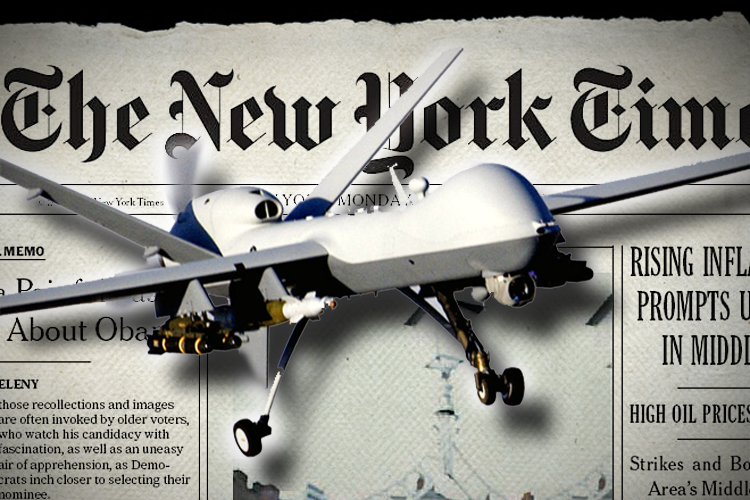
Written by Robert Parry; Originally appeared at Consortiumnews
Traditional U.S. journalism and the American people are facing a crisis as the preeminent American newspaper, The New York Times, has fully lost its professional bearings, transforming itself into a neoconservative propaganda sheet eager for a New Cold War with Russia and imposing a New McCarthyism on public debate.
The crisis is particularly acute because another top national newspaper, The Washington Post, is also deeply inside the neocon camp.
The Times’ abandonment of journalistic principles has become most noticeable with its recurring tirades about Russia, as the Times offers up story after story that would have embarrassed Sen. Joe McCarthy and his 1950s Red-baiters.
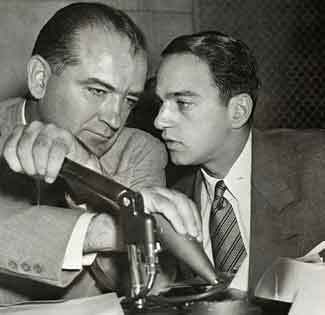
Lawyer Roy Cohn (right) with Sen. Joseph McCarthy.
Operating without any actual evidence, a recent Times article by Neil MacFarquhar sought to trace public challenges to official U.S. government narratives on world events to a massive “disinformation” campaign by Russian intelligence. Apparently, it is inconceivable to the Times that independent-minded people might simply question some of the dubious claims made by Official Washington.
Perhaps most stunningly, the Times sought to prove its point by citing the slogan of Russia’s English-language television network, saying: “RT trumpets the slogan ‘Question More.’”
So, now, presumably if someone suggests questioning a claim from the U.S. government or from the NATO alliance, that person is automatically a “Russian agent of influence.” For a major newspaper to adopt such a position is antithetical to the tenets of journalism which call on us journalists to question everything.
The Times’ position is particularly outrageous because many key claims by the U.S. government, including some used to justify aggressive wars against other countries, have turned out to be false. Indeed, the Times has been caught peddling some of these bogus claims, often fed to the “newspaper of record” by U.S. government officials or from think tanks funded by American military contractors.
Disinformation Conduit
Most memorably, in 2002, the Times pushed disinformation about the Iraqi government reconstituting its nuclear weapons program, a lie that was then cited by Vice President Dick Cheney and other senior officials to help stampede the American people behind the 2003 invasion of Iraq.
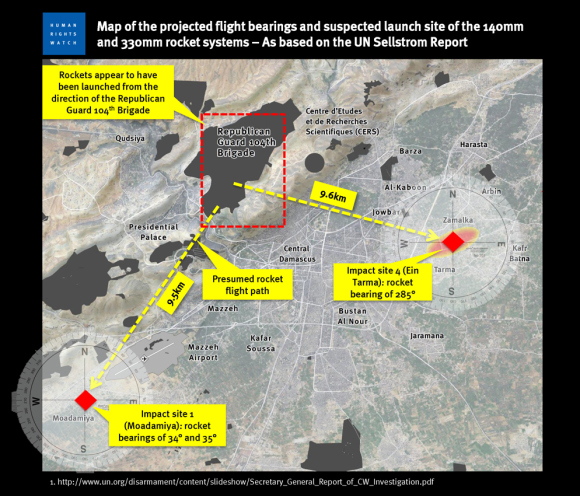
The controversial map developed by Human Rights Watch and embraced by the New York Times, supposedly showing the flight paths of two missiles from the Aug. 21 Sarin attack intersecting at a Syrian military base.
Lesser known moments of the Times serving as a disinformation conduit include a discredited assertion about the 2013 sarin attack in Syria, in which the Times purported to show how the flight paths of two missiles traced back to a Syrian military base, only later to grudgingly acknowledge that aeronautical experts judged that the one missile found to be carrying sarin had a maximum range of about one-fourth the required distance.
During the 2014 Ukraine crisis, the Times accepted photographs from the U.S. State Department which purported to show Russian military personnel in Russia and then later inside Ukraine, except that it turned out that the photograph supposedly taken in Russia was actually taken in Ukraine, destroying the premise of the Times article.
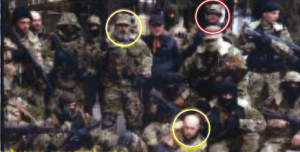
Photograph published by the New York Times purportedly taken in Russia of Russian soldiers who later appeared in eastern Ukraine. However, the photographer has since stated that the photo was actually taken in Ukraine, and the U.S. State Department has acknowledged the error.
Yet, the Times holds itself out as some paragon of objectivity. This delusion further underscores how out of control and indeed dangerous the Times has become as a source of U.S. government disinformation, while accusing others of spreading Russian disinformation which often isn’t disinformation at all.
In its recent article, the Times cites reasonable questions raised by Swedish citizens about a proposal for the country entering into a military association with NATO and dismisses these concerns as proof of Russian government propaganda and lies:
“The claims were alarming: If Sweden, a non-NATO member, signed the deal, the alliance would stockpile secret nuclear weapons on Swedish soil; NATO could attack Russia from Sweden without government approval; NATO soldiers, immune from prosecution, could rape Swedish women without fear of criminal charges.”
Yet, all these worries raised by Swedish citizens – and cited by MacFarquhar in the Times – are not unreasonable concerns since nuclear weapons often are stored in NATO countries, NATO members are obliged to go to war to protect allies, and there have been problems with rape cases in countries with NATO or other foreign bases.
How those realities might affect a country agreeing to a NATO military association are reasonable concerns for Swedes to raise, but instead these worries are dismissed as Russian disinformation without any evidence to support the charge.
No Evidence
MacFarquhar even concedes the point that his lead allegation lacks evidentiary support, writing: “As often happens in such cases, Swedish officials were never able to pin down the source of the false reports.”
MacFarquhar then adds: “But they, numerous analysts and experts in American and European intelligence point to Russia as the prime suspect, noting that preventing NATO expansion is a centerpiece of the foreign policy of President Vladimir V. Putin, who invaded Georgia in 2008 largely to forestall that possibility.”
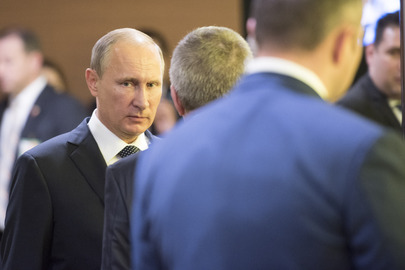
Russian President Vladimir Putin, following his address to the UN General Assembly on Sept. 28, 2015. (UN Photo)
Though MacFarquhar cites the Russian “invasion” of Georgia supposedly to thwart its entrance into NATO as a flat fact to support his thesis, that historical reference is a far more complicated issue since it was Georgia that launched an attack on South Ossetia, a breakaway province, and killed Russian peacekeepers stationed there.
An investigation by the European Union laid most of the blame on Georgia for initiating the conflict, with the Russians then reacting to the Georgian assault. A 2009 report on the E.U. mission led by Swiss diplomat Heidi Tagliavini rejected Georgian claims about self-defense, finding that Georgia, not Russia, started the conflict.
“None of the explanations given by the Georgian authorities in order to provide some form of legal justification for the attack lend it a valid explanation,” Tagliavini said.
The E.U. report stated: “There was no ongoing armed attack by Russia before the start of the Georgian operation. Georgian claims of a large-scale presence of Russian armed forces in South Ossetia prior to the Georgian offensive could not be substantiated by the mission. It could also not be verified that Russia was on the verge of such a major attack.”
In other words, Putin’s military did not “invade” Georgia in 2008 “largely to forestall” Georgia’s entrance into NATO, but as a reaction – arguably an over-reaction – to Georgia’s violent offensive into South Ossetia.
Yet, MacFarquhar cites this dubious point as some sort of indirect “evidence” that Putin is responsible for questions posed by Swedish citizens about what a NATO association would mean for them.
After acknowledging no real evidence and citing a historical “fact” that really isn’t a fact, MacFarquhar expands his conspiracy theory into more recent events claiming that Putin “has invested heavily in a program of ‘weaponized’ information, using a variety of means to sow doubt and division. …
“The fundamental purpose of dezinformatsiya, or Russian disinformation, experts said, is to undermine the official version of events — even the very idea that there is a true version of events — and foster a kind of policy paralysis.”
The MH-17 Case
As an example, MacFarquhar cites the case of the shoot-down of Malaysia Airlines Flight 17 over eastern Ukraine on July 17, 2014, claiming “Russia pumped out a dizzying array of theories.” The Times correspondent then asserts as flat fact that “The cloud of stories helped veil the simple truth that poorly trained insurgents had accidentally downed the plane with a missile supplied by Russia.”
But, according to official investigations that have been underway for more than two years, MacFarquhar’s claim is not “the simple truth,” as he put it. Last year’s report by the Dutch Safety Board reached no conclusion about who was responsible for shooting down the plane, killing 298 people.

The Dutch Safety Board’s reconstruction of where it believed the missile exploded near Malaysia Airlines Flight 17 on July 17, 2014.
Indeed, the DSB’s report included a statement by Dutch intelligence (reflecting NATO’s intelligence data) that the only powerful anti-aircraft-missile systems in eastern Ukraine on that day – capable of hitting MH-17 at 33,000 feet – were under the control of the Ukrainian military. (Though an official document, this Dutch intelligence report has never been mentioned by The New York Times, presumably because it conflicts with the favored Russia-did-it narrative.)
The U.S. government, which in the five days after the crash did rush to a judgment blaming ethnic Russian rebels supposedly using a Russian-supplied Buk missile, then went silent on the issue after CIA analysts had a chance to examine the evidence in more detail.
Despite appeals from the families of Dutch victims, including the father of the one young American citizen who died in the crash, the U.S. government has refused to release its radar, satellite images and other intelligence information that presumably could establish exactly who was responsible.
Why the U.S. government would obstruct the investigation into this tragedy if indeed the evidence proved Putin’s responsibility doesn’t make any sense. Indeed, it is the kind of question that a responsible journalist would press the U.S. government to answer, but MacFarquhar and the Times take the pressure off by simply reaffirming the impression that the U.S. government wants the public to have: the Russkies did it.
In the weeks after the crash, I was told by a source briefed by U.S. intelligence analysts that the secret U.S. data points the finger of guilt at a rogue Ukrainian military operation, which would fit with the statement by Dutch intelligence. But whatever the ultimate finding, it is simply bad journalism to state as flat fact something that remains seriously in doubt, a professional failure reminiscent of how the Times and Post treated Iraq’s WMD as a certainty in 2002-2003.
More Insidious
But there is something even more insidious about what The New York Times and The Washington Post have been up to. They are essentially saying that any questioning of the official U.S. government narrative on any international topic puts you in league with Moscow in its purported attempt to “weaponize” information, whatever that is supposed to mean.
The two newspapers are engaging in a breathtaking form of McCarthyism, apparently in some twisted effort to force a neoconservative ideological conformity on the American people in support of the New Cold War.
There is also a stunning lack of self-awareness. While MacFarquhar sees a Russian desire to portray U.S. life as “hellish,” including RT’s decision to show protest demonstrations – rather than some speeches – during the Republican and Democratic conventions, he and other writers who have picked up this theme consistently present the situation in Russia in the darkest possible terms.
Relatively innocent actions, such as the Kremlin seeking to make its case to the world, are transformed into evil deeds, using buzzwords like “weaponized” information and “hybrid war.” Yet, there is no reference to the billions upon billions of dollars that the U.S. government has invested in disseminating propaganda and funding political activists around the world.
NATO has even established what it calls a “Strategic Communications Command,” or Stratcom, in Riga, Latvia, which – as veteran war correspondent Don North has written – views “the control and manipulation of information as a ‘soft power’ weapon, merging psychological operations, propaganda and public affairs under the catch phrase ‘strategic communications.’
“This attitude has led to treating psy-ops manipulative techniques for influencing a target population’s state of mind and surreptitiously shaping people’s perceptions as just a normal part of U.S. and NATO’s information policy. …
“And, as part of this Brave New World of ‘strategic communications,’ the U.S. military and NATO have now gone on the offensive against news organizations that present journalism which is deemed to undermine the perceptions that the U.S. government seeks to convey to the world.”
In other words, the U.S. government and NATO are engaged in what psychologists call “projection,” accusing someone else of one’s own behavior. Yet The New York Times has never investigated Washington’s and NATO’s involvement in “strategic communications.” Only the Russians do such dirty deeds.
A Darker Side
But there is even a darker side to the Times’ recent propaganda barrage about Russian propaganda. On the heels of MacFarquhar’s indictment of Russia for questioning Washington’s official narratives, the Times published a vicious attack on WikiLeaks and its founder, Julian Assange, entitled “How Russia Often Benefits When Julian Assange Reveals the West’s Secrets.”
The article portrays Assange as a participant, wittingly or otherwise, in Russia’s allegedly nefarious scheme to release truthful information, such as the Democratic National Committee’s emails confirming what many had long suspected, that some party officials were favoring Hillary Clinton over her rival, Bernie Sanders. No one has suggested that the emails aren’t real.
However, without presenting any real evidence proving that Russian intelligence was responsible for the hack, the Times and the rest of the mainstream U.S. news media have made that assumption conventional wisdom based on the opinions of some unnamed U.S. officials.
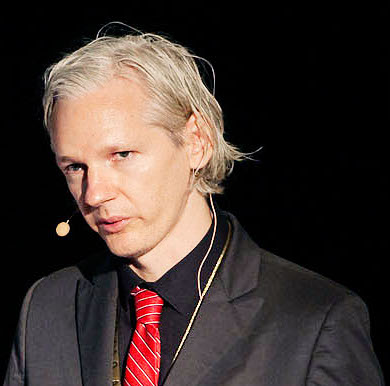
WikiLeaks founder Julian Assange at a media conference in Copenhagen, Denmark. (Photo credit: New Media Days / Peter Erichsen)
Or as the Times’ takedown of Assange wrote, “United States officials say they believe with a high degree of confidence that the Democratic Party material was hacked by the Russian government. …That raises a question: Has WikiLeaks become a laundering machine for compromising material gathered by Russian spies? And more broadly, what precisely is the relationship between Mr. Assange and Mr. Putin’s Kremlin? …
“Among United States officials, the emerging consensus is that Mr. Assange and WikiLeaks probably have no direct ties to Russian intelligence services. But they say that, at least in the case of the Democrats’ emails, Moscow knew it had a sympathetic outlet in WikiLeaks, where intermediaries could drop pilfered documents in the group’s anonymized digital inbox.”
Though it’s nice that some U.S. officials acknowledge a lack of evidence proving an operational relationship between Assange and Russian intelligence, the fact that a high-profile journalistic institution, such as WikiLeaks, has been under that sort of U.S. government investigation should be troubling to the Times and other news organizations.
However, instead the newspaper appears disappointed that it cannot declare outright that Assange is a “Moscow stooge.” (Also note that in the last passage, the Times treats the suspicion that Russian intelligence hacked the Democratic emails as flat fact when U.S. intelligence officials say they don’t know for sure.)
Verify, Don’t Moralize
The usual rule of thumb for journalists is to accept and verify information regardless of where it comes from. While occasionally you get a selfless leaker, it’s more common to get leaks from interested parties seeking to undermine their rivals. We see that in legal proceedings when lawyers supply documents helpful to their cases and in political contests when campaigns dig up dirt on their opponents.
Yet, journalists don’t throw away newsworthy information because it may be self-serving. We check it out and – if it checks out – we use it. The only real problem would be if you run the material as flat fact, without caveats, and it turns out to be false, as has happened repeatedly with material that the U.S. government has leaked to the Times and the Post.
What is particularly unprofessional about how the Times is treating Assange is that no one is saying that the Democratic Party emails are disinformation; they appear to be quite real and reflect a newsworthy concern, which is: Did the Democratic National Committee seek to throw the presidential nomination to Hillary Clinton?
But the Times’ unprofessional treatment of truthful information from WikiLeaks as well as the Times’ disdain for legitimate debate about the New Cold War with Russia has contributed to another dangerous development – a McCarthyistic launching of official U.S. government investigations into people who question the official Washington narratives.
An Official Investigation
The Washington Post reported on Tuesday that “U.S. intelligence and law enforcement agencies are investigating what they see as a broad covert Russian operation in the United States to sow public distrust in the upcoming presidential election and in U.S. political institutions. …
“The aim is to understand the scope and intent of the Russian campaign, which incorporates cyber-tools to hack systems used in the political process, enhancing Russia’s ability to spread disinformation. … A Russian influence operation in the United States ‘is something we’re looking very closely at,’ said one senior intelligence official,” while admitting that there is no “definitive proof” of such a Russian scheme.
The danger of this investigation – and what a normal news media would focus on – is the U.S. government taking an unfocused look at how Russia supposedly influences the U.S. public debate, a probe that could easily cross the line into questioning the loyalty of Americans who simply dispute what the U.S. government is claiming about current events.
The Post reported, “U.S. intelligence officials described the [Russian] covert influence campaign here as ‘ambitious’ and said it is also designed to counter U.S. leadership and influence in international affairs. …
“Russia has been in the vanguard of a growing global movement to use propaganda on the Internet to influence people and political events, especially since the political revolt in Ukraine, the subsequent annexation of Crimea by Russia, and the imposition of sanctions on Russia by the United States and the European Union. …
“‘Our studies show that it is very likely that [the influence] operations are centrally run,’ said Janis Sarts, director of the NATO Strategic Communications Center of Excellence, a research organization based in Riga, Latvia.”
Yes, that is the same NATO Stratcom complex that, as Don North reported, blends psychological operations with traditional public relations. Yet, you wouldn’t know that from reading The Washington Post’s article, which cites Stratcom as a source for accusing Russia of running influence operations.
A Vast Conspiracy
According to the Post, Sarts “also said there is ‘a coordinated effort involving [groups using] Twitter and Facebook and networks of bots to amplify their message. The main themes seem to be orchestrated rather high up in the hierarchy of the Russian state, and then there are individual endeavors by people to exploit specific themes.’
“Sarts said the Russian propaganda effort has been ‘successful in exploiting the vulnerabilities within societies.’ In Western Europe, for instance, such Russian information operations have focused on the politically divisive refugee crisis.”
In other words, any reporting or commenting on significant foreign policy issues could open a journalist or a citizen to a U.S. government investigation into whether you are part of some nefarious Russian propaganda/disinformation scheme.
This McCarthyistic investigative style has already begun to have a chilling effect on public debate in the United States where dissident views on Russia, Syria or other hot topics are quickly disparaged as enemy propaganda. Almost anyone who questions whether a new, costly and dangerous Cold War is necessary is immediately tagged as a “Russian agent of influence,” a “Putin apologist,” or a “Moscow stooge.”
In this case, the Democrats have been particularly aggressive in playing the Joe McCarthy role by denouncing Republican presidential nominee Donald Trump in such overheated terms, even suggesting his disloyalty for suggesting that he could, as President, get along with Putin.
During the McCarthy era of the 1950s, defense of freedom of thought required courageous journalists, most notably Edward R. Murrow, to stand up to the often unfounded smears against the patriotism of Americans. In 2016, however, it is the prestige news media, particularly The New York Times and The Washington Post, that have been leading the rush into the New Cold War and into the New McCarthyism.
Investigative reporter Robert Parry broke many of the Iran-Contra stories for The Associated Press and Newsweek in the 1980s. You can buy his latest book, America’s Stolen Narrative, either in print here or as an e-book (from Amazon andbarnesandnoble.com).






I vary my reading a bit, to get different perspectives. Some I know are straight propaganda, with Reuters as a prime and gleaming example. Others are balanced, some offer a particular perspective and still more are a mix of everything. I want to take in as much data and as many view points as feasible, in order to ascertain the highest degree of certitude possible. I wanna kno´!
Last week I began to read the Post. Man, they are a trip. I have made three comments on articles there and am experiencing exactly what you are talking about. Specifically one responder to something I offered was that I was a pretending to be a ´POV´ ( whatever that means ) and I was probably a ´Russian troll´. Whatever dudes.
For me, the nexus of this always goes back to Bill Clinton. The ´I didn´t inhale´claim. This is where it began. What angered me at the time is that I watched him that day, intent on keeping an open mind and I was sick of GB Sr. That moment changed a lot for me. The question that came to mind was: how much BS are we supposed to swallow? The news media should have transported him and the misses directly to the trash barrel, the moment those words were uttered. Instead, they embraced it all.
I thank Southfront in offering this article for viewing. It is timely and right on target.
The number of readers of these propaganda rags like nyt and wp has been in a downward spiral for years. One thing about them going so overboard on the “Russian propaganda” lies is that it shows how desperate the propaganda department of the illegitimate us central government is getting. I completely agree with the author about the projecting. Not only the corporate media but the state dept, pentagon, etc also tends to do,this. This also seems to be setting up to try to declare the sham of an election invalid if the rigging doesn’t go right and Trump wins.